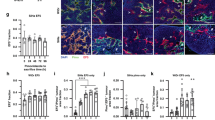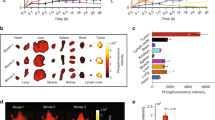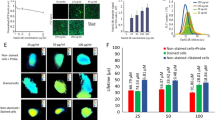Abstract
Frequency distributions for intracapillary HbO2 saturation were determined for two murine tumour lines (KHT, RIF-1) and two human ovarian carcinoma xenograft lines (MLS, OWI) using a cryospectrophotometric method. The aim was to search for possible relationships between HbO2 saturation status and tumour volume, tumour pH and fraction of radiobiologically hypoxic cells. Tumour pH was measured by 31P NMR spectroscopy. Hypoxic fractions were determined from cell survival curves for tumours irradiated in vivo and assayed in vitro. Tumours in the volume range 100-4000 mm3 were studied and the majority of the vessels were found to have HbO2 saturations below 10%. The volume-dependence of the HbO2 frequency distributions differed significantly among the four tumour lines; HbO2 saturation status decreased with increasing tumour volume for the KHT, RIF-1 and MLS lines and was independent of tumour volume for the OWI line. The data indicated that the rate of decrease in HbO2 saturation status during tumour growth was related to the rate of development of necrosis. The volume-dependence of tumour pH was very similar to that of the HbO2 saturation status for all tumour lines. Significant correlations were therefore found between HbO2 saturation status and tumour pH, both within tumour lines and across the four tumour lines, reflecting that the volume-dependence of both parameters probably was a compulsory consequence of reduced oxygen supply conditions during tumour growth. Hypoxic fraction increased during tumour growth for the KHT, RIF-1 and MLS lines and was volume-independent for the OWI line, suggesting a relationship between HbO2 saturation status and hypoxic fraction within tumour lines. However, there was no correlation between these two parameters across the four tumour lines, indicating that the hypoxic fraction of a tumour is not determined only by the oxygen supply conditions; other parameters may also be important, e.g. oxygen diffusivity, rate of oxygen consumption and cell survival time under hypoxic stress.
This is a preview of subscription content, access via your institution
Access options
Subscribe to this journal
Receive 24 print issues and online access
$259.00 per year
only $10.79 per issue
Buy this article
- Purchase on Springer Link
- Instant access to full article PDF
Prices may be subject to local taxes which are calculated during checkout
Similar content being viewed by others
Author information
Authors and Affiliations
Rights and permissions
About this article
Cite this article
Rofstad, E., Fenton, B. & Sutherland, R. Intracapillary HbO2 saturations in murine tumours and human tumour xenografts measured by cryospectrophotometry: relationship to tumour volume, tumour pH and fraction of radiobiologically hypoxic cells. Br J Cancer 57, 494–502 (1988). https://doi.org/10.1038/bjc.1988.113
Issue Date:
DOI: https://doi.org/10.1038/bjc.1988.113



